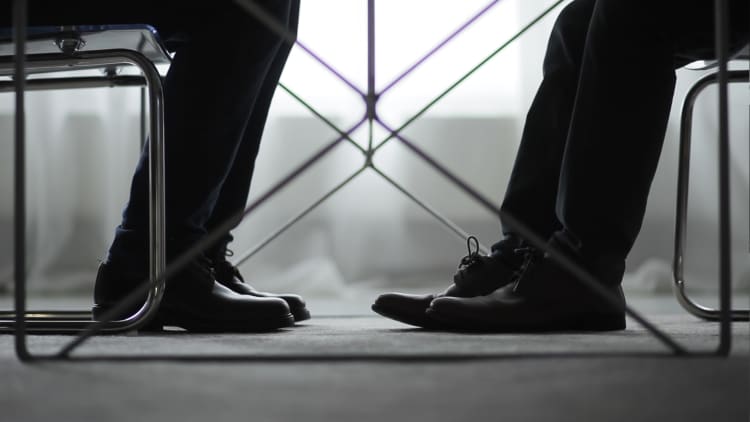Since you're not on the receiving end of your non-verbal communication with others, it's challenging to really "see" what signals you convey with your body language. Body language is important. In fact, your non-verbal signals are responsible for communicating 55 percent of your message.
If you keep getting passed up for a coveted promotion or are frequently perplexed by how exchanges with co-workers end up not the way you intended, it just might be time to get some feedback about the non-verbal messages you send at work. Ask a trusted mentor or colleague for honest feedback, practice dialogue in front of the mirror or video yourself to see opportunities you have for improvement.
If you exhibit any of the body language mistakes to avoid at work that I outline below, it's time to commit to breaking the habit.
More from Bernard Marr:
9 simple tricks to boost your confidence at work
10 more tell-tale signs that you have a great boss
7 habits successful people avoid
1. Concentration face instead of smiles
Even though many of you who don't smile often at work aren't necessarily grumpy and dissatisfied, that's what your face conveys. When you walk into a meeting, smile. When you talk on the phone, smile. People want to interact with positive and confident people, so do what you can to plaster a smile on your face whenever you can. And, it's not just good for others. Smiling or even forcing a smile will reduce your stress and make you happier.
2. Wimpy handshake
The way you connect with another when you grab their hand in a handshake is important. You should have good posture, a firm (not rigid) shake and look them in the eye. These actions exude your self-assuredness. A wimpy grip just opens you up to be misunderstood by those you interact with.
3. Hand placement
In addition to your handshake, your hands play an important role in complementing or distracting from your verbal communication. If you are too animated with your hands while you speak, others may believe you're unprofessional and immature. Yet, you should use your hands when you speak, because according to a study by Colgate University people are more likely to listen to you when you do. Those that hide their hands when interacting with others are often viewed as untrustworthy.
4. Breaking eye contact
When interviewing for a job, most of us know it's important to maintain eye contact with the person across the table yet some of us forget to continue this practice once on the job. While you shouldn't stare at the other person, your gaze shouldn't dart back and forth across the room or break away too soon.
When someone is speaking to you, look them in the eye—not at your phone, your computer or your notepad. Eye contact helps connection and builds trust. And, no matter how irritated you are, follow your mom's rules from when you were a teen and never roll your eyes. That's just rude.
5. Nervous gestures
We all have times when we are nervous or uncomfortable in a situation. It's during those times that our nervous habits have a way of showing up—cracking knuckles, tapping fingers, twirling hair, biting your nails, lip or a pencil.
And, if you do these things out of boredom you are communicating the same thing—you are not confident or trustworthy in a tense situation. Try to reduce your stress beforehand by taking a few deep breaths, visualizing a serene memory and keeping objects that you will fidget with out of your reach.
6. Leaning too far in or out from others
First, you should always stay oriented to the conversation to show that you are engaged. It's always suggested to maintain good personal space; the perfect amount of distance between you and a colleague is between three to eight feet according to Square Up.
However, if you lean too far into a conversation you might be seen as too aggressive and if you slouch or lean back your body language sends the message that you're not engaged or even lazy. Try to maintain a neutral body posture at all times. Even though our workplaces are much more casual than they used to be, leaning on a wall or furniture can also be interpreted to mean you're too comfortable and don't take the job seriously.
7. Glances at watch or clock or phone
People looking at their phones 24/7 and even during meetings and presentations may be commonplace, but that doesn't mean it's sending the right message. Unless your job requires that your attention be on your phone every minute of the working day, be respectful of the people in the room and don't engage with your phone more than you engage with them.
For similar reasons, incessant glancing at the clock or your watch conveys to others in the room you're bored, disinterested or just plain rude. None of these are messages you should convey in a professional setting.
8. Crossing your arms
When you have your arms crossed and are responding to questions, you look defensive. This body posture makes you seem distant and stubborn, and that's not who anyone wants on their team. Do what you can to keep your arms at your sides.
Don't underestimate the power of your non-verbal communication. If you experience a disconnect when you communication, it might be time to look at what message you send with your body language.
Barnard Marr is a best-selling author, keynote speaker and leading business and data expert. His free eBook, "Big Data in Practice," is out now.
Don't miss: Bill Gates and Richard Branson agree on why it's important to have 'long-shot' goals
Like this story? Like CNBC Make It on Facebook.



